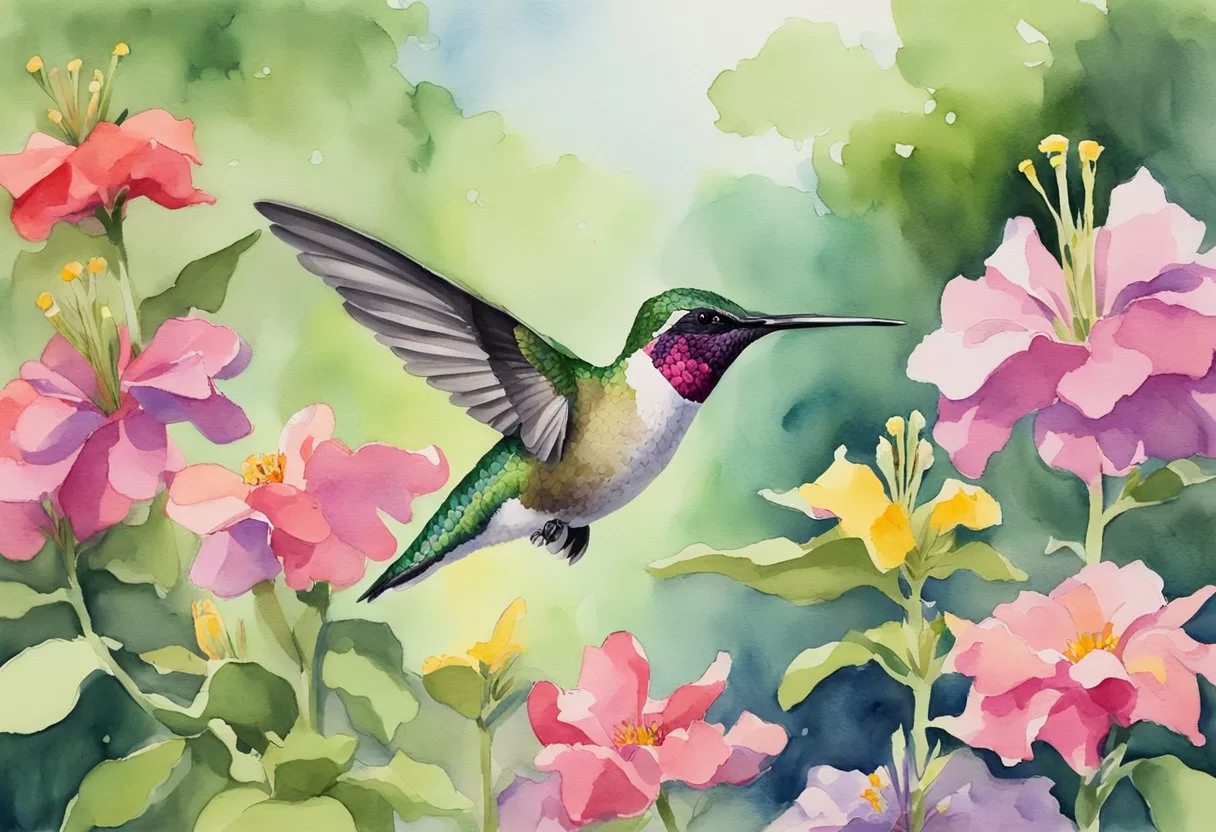Understanding Ruby-Throated Hummingbird Ecology
The Ruby-throated Hummingbird is a remarkable species that showcases an intricate relationship with its environment. This section covers its habitat and distribution, migration patterns, and dietary preferences that contribute to its survival and success.
Habitat and Distribution
Ruby-throated Hummingbirds thrive in a range of habitats, including gardens, woodlands, and open areas with abundant flowering plants. Their presence is most notable in the eastern United States, extending from southern Michigan to the Northeast and beyond.
These birds prefer regions with nectar-rich flowers that bloom during their migration and breeding seasons. They can also be found in areas of Ontario and parts of Montana. The availability of suitable nesting sites and food sources significantly influences their distribution.
Migration Patterns
Ruby-throated Hummingbirds are known for their long migratory journeys, typically traveling between North America and Central America. In spring, they return to their breeding grounds, often arriving in April.
Migration routes vary, with many individuals traversing the Gulf of Mexico. This is a critical period, as they rely on food reserves built up before departing. Knowing their migration patterns helps identify the best times to set up feeders, ensuring they have a reliable food source upon arrival.
Diet and Foraging Behavior
The diet of Ruby-throated Hummingbirds primarily consists of nectar, which provides essential sugars for energy. They are particularly drawn to brightly colored flowers, but they also consume small insects and spiders for protein.
Typically, they forage in a repetitive pattern, visiting multiple flowers in search of food. This behavior benefits not just the hummingbirds but also encourages pollination within their environment. Providing a variety of native flowers can attract these birds and support their dietary needs throughout the growing season.
Nurturing Your Backyard for Hummingbirds
Creating a welcoming environment for ruby-throated hummingbirds involves specific strategies. Key elements include cultivating gardens rich in nectar-producing plants and ensuring proper feeder setup. Attention to conservation also plays a vital role in attracting these beautiful birds.
Creating Hummingbird-Friendly Gardens
To attract hummingbirds, it is essential to incorporate nectar-rich flowers into gardens. Optimal choices include salvia, bee balm, and cardinal flower. These native plants not only provide food but also support local ecosystems.
Planting in clusters enhances visibility and encourages birds to visit. It’s also important to avoid using pesticides that can harm hummingbirds and other beneficial wildlife. Maintaining a diverse garden will create an appealing environment.
In addition to flowers, including perches like low branches or tall grasses provides hummingbirds areas to rest between feedings. Ensuring a continuous bloom throughout the season will keep the feeders bustling with activity.
Feeder Selection and Maintenance
Selecting the right hummingbird feeder is crucial. Look for models that are easy to clean, with built-in ant moats and bee guards to keep unwanted insects away. A bright red feeder is particularly attractive to hummingbirds.
When filling feeders, a mixture of sugar water (1 part sugar to 4 parts water) mimics natural nectar. Avoid using red dye, as it can be harmful. Regular maintenance is essential; feeders should be cleaned every few days to prevent mold or fermentation.
Position feeders away from domestic cats to minimize predation risks. Ideally, they should be placed near flowering plants, allowing birds to easily transition between natural food sources and feeders.
Supporting Hummingbird Conservation
Supporting hummingbird conservation involves awareness and proactive measures. Homeowners can reduce pesticide use significantly. Instead, opt for natural pest management strategies to protect these beneficial pollinators.
Creating patterns of native habitats can also help sustain hummingbird populations. Joining local conservation groups or participating in community science projects can further support their efforts.
Additionally, providing clean water sources, such as birdbaths, enhances garden appeal. Keeping the birdbath clean and fresh encourages birds to visit while helping them stay hydrated. Simple actions can have a significant impact on the well-being of ruby-throated hummingbirds.
The Behavior and Life Cycle of Ruby-Throats
Ruby-throated Hummingbirds exhibit fascinating behaviors and a unique life cycle that are crucial for their survival, especially during migration and nesting. Their courtship rituals, nesting habits, and challenges related to migration reveal the complexities of their life stages.
Courtship and Nesting Habits
During the courtship season, typically in late April to early May, male Ruby-throated Hummingbirds display vibrant aerial shows to attract females. They perform rapid, darting flights and create a distinct humming sound by beating their wings at high speed.
Once mating occurs, the female begins the nesting process alone. She constructs a small, cup-shaped nest using materials such as spider silk, dandelion fluff, and thistle down. This nesting behavior allows her to camouflage the nest among foliage, providing protection from predators. After laying two eggs, she incubates them for about 14 to 19 days until they hatch.
Hummingbird Banding Insights
Hummingbird banding provides valuable data on the behavior and migration patterns of Ruby-throats. Hummingbird banders capture these birds carefully and attach small, numbered bands to their legs. This practice allows researchers to track individuals over time, gathering insights into their longevity, migration routes, and reproductive success.
Data from banding efforts show that Ruby-throated Hummingbirds can travel hundreds to thousands of miles from their breeding grounds to winter in Central America. Understanding their migration aids in conservation efforts, helping researchers protect vital habitats along their migratory paths.
Challenges of Migratory Life
Migration poses significant challenges for Ruby-throated Hummingbirds. They must navigate long distances, often facing inclement weather and limited food sources. To survive, they rely on their ability to enter a state of torpor, which conserves energy during harsh conditions.
The timing of their migration is critical. They generally leave for their wintering grounds in September and return in spring. Conservation efforts are crucial, as loss of habitat and food sources can severely threaten migratory routes. Protecting flowers that provide nectar during migration is essential for ensuring these birds continue to thrive.
Share this content:

Post Comment
You must be logged in to post a comment.